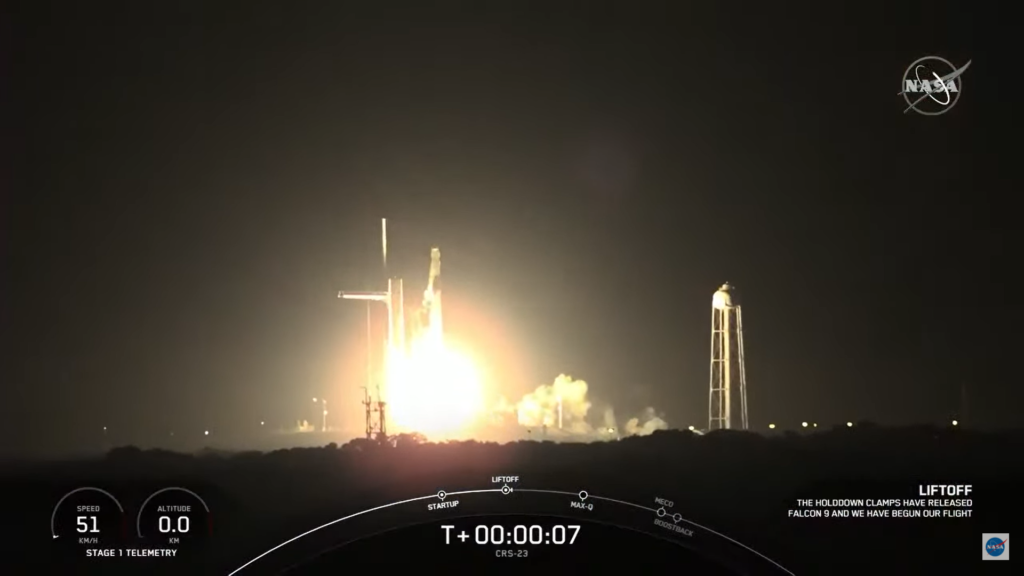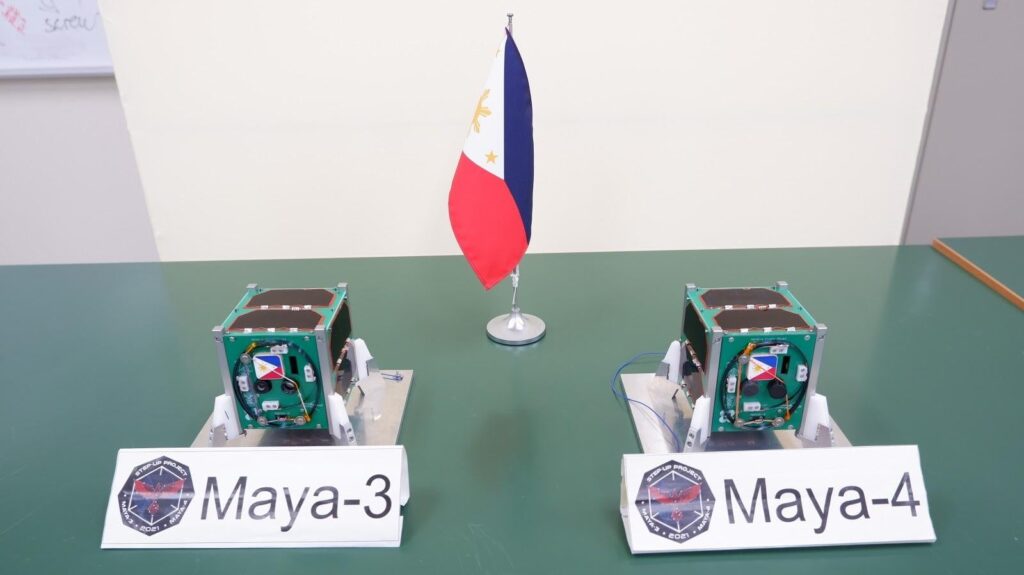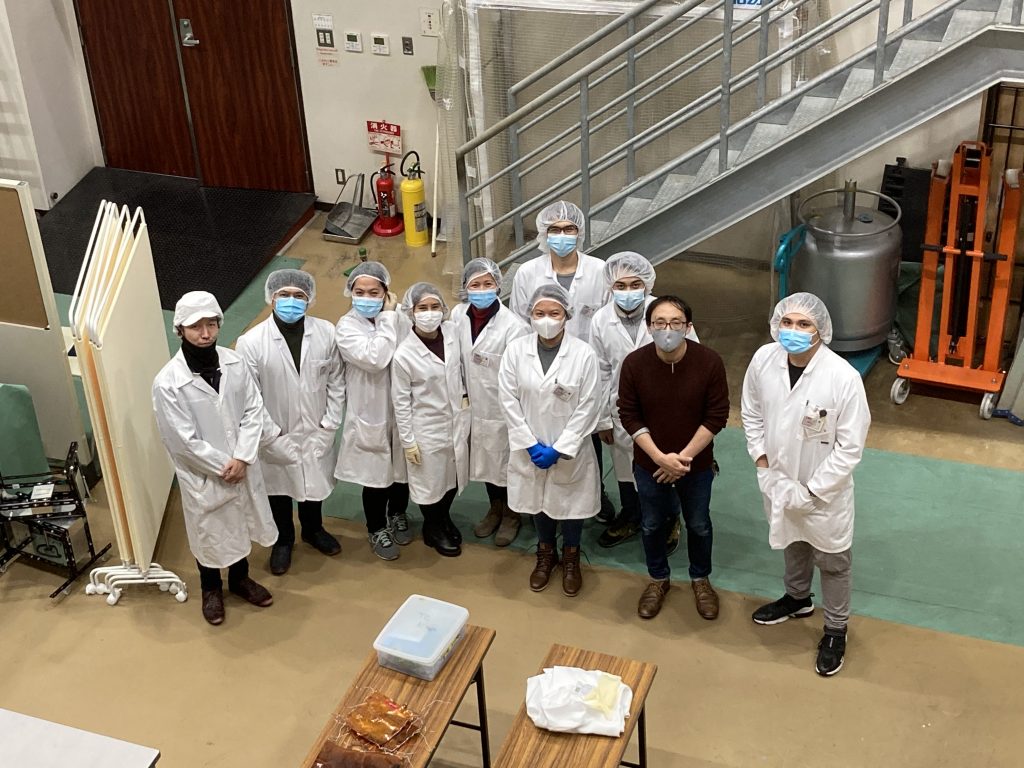The CubeSats Maya-3 and Maya-4 were launched to the ISS on August 29, 2021 at 3:14 P.M. (PST) aboard a SpaceX Falcon 9 rocket’s Dragon C208 as part of SpaceX Commercial Resupply Mission-23 (SpX-23). Weighing approximately 1.15 kilograms per unit with 10-centimeter cubic frames, these CubeSats house components that are designed to demonstrate nanosatellite-based remote data collection systems and optical imaging. Once the CubeSats are released from the ISS, they will move along an orbit similar to the space station’s, which is at an altitude of approximately 400 kilometers.

Photo captured via NASA Live stream


The Maya-3 and Maya-4 CubeSats are fashioned after the bus heritage of Maya-1, but with enhancements incorporated from the previous design. Maya-3 and Maya-4 are mostly identical with only difference in a mission, that is the near-infrared camera, which is mounted only on Maya-4. These latest CubeSats were built under the Space Space Science and Technology Proliferation through University Partnerships (STeP-UP) project of the STAMINA4Space Program, which is funded by the Department of Science and Technology (DOST), and is implemented by the University of the Philippines Diliman (UPD) and the DOST Advanced Science and Technology Institute (DOST-ASTI). The nanosatellite development track under the Master of Science (MS) or Master of Engineering (MEng) program of the Electrical and Electronics Engineering Institute of the University of the Philippines Diliman (UPD-EEEI) is also implemented in collaboration with the Kyushu Institute of Technology (Kyutech) in Japan and with scholarship support from the Department of Science and Technology’s Science Education Institute (DOST-SEI).
The Maya-3 and Maya-4 CubeSats provide local opportunities to learn and acquire space technology know-how, and hands-on experience in satellite development, which contributes to building human resources for furthering the country’s space initiatives and activities. Its mission and payloads were conceptualized and developed to test and demonstrate technologies that can later on be used to provide data that may be used in a number of applications across various sectors such as agriculture, environment and natural resources, and disaster risk reduction and management, among others. These CubeSats can also be used to demonstrate technologies such as data collection systems that work with ground-based sensors and radios that serve the amateur radio community and emergency response teams.
“The success of Maya-3 and Maya-4 will prove that CubeSats can be successfully built locally,” said STeP-UP Project Leader, Prof. Paul Jason Co. “The knowledge and experience gained from this endeavor can and will be shared to any other institutions through collaboration and cooperation.”

Top (L-R): Renzo Wee, Christy Raterta, Lorilyn Daquioag, Derick Canceran
Bottom (L-R): Judiel Reyes, Gladys Bajaro, Marielle Magbanua-Gregorio, Bryan Custodio

L-R: Derick Canceran, Judiel Reyes, Christy Raterta, Gladys Bajaro, Marielle Magbanua-Gregorio, Lorilyn Daquioag, Bryan Custodio, and Renzo Wee
The development of the CubeSats are part of the course requirements of the Master of Science (MS) or Master of Engineering (MEng) under the nanosatellite engineering track. The first batch of STeP-UP scholars are composed of eight (8) students who received scholarship support from DOST-SEI. They are Gladys Bajaro, Derick Canceran, Bryan Custodio, Lorilyn Daquioag, Marielle Magbanua-Gregorio, Christy Raterta, Judiel Reyes, and Renzo Wee.
Prior to the launch, the CubeSats were tested thoroughly to ensure that they can survive the launch and harsh space conditions. The team performed space environment tests of the two CubeSats and analyzed the results. Reports detailing the results of various tests were then sent to the Japan Aerospace Exploration Agency (JAXA) for evaluation. After satisfying the set acceptance requirements, the CubeSats were turned over to JAXA for their launch to the ISS.
How are Maya-3 and Maya-4 different from or similar to its predecessors?
“The Maya-3 and Maya-4 CubeSats use the heritage bus of Maya-1 — which was developed as part of the BIRDS-2 Project led by Kyutech and launched along with Bhutan-1 (Bhutan) and UiTMSat-1 (Malaysia),” said the scholars. “Maya-3 and Maya-4 incorporate enhancements from the previous design including improvements in the antenna board. They are mostly identical, only with a difference in a mission, that is, the Near-infrared camera which is mounted only on Maya-4.
DOST-SEI Director Dr. Josette Biyo commended the scholars’ success and noted how this relates to the attached DOST agency’s priority research areas. “The scholarship programs of the DOST through the Science Education Institute were designed as the government’s primary response to build a critical mass of S&T human resources that will propel us to a globally competitive state,” she said. “Providing scholarships through the [STeP-UP Project] is one the Institute’s ways of contributing to the growth of the space ecosystem in the country. Our goal is to produce a workforce trained specifically on conducting R&D activities in vital areas of space science, technology, and allied fields. With the impending launch of the Maya-3 and Maya-4 cube satellites in space, which were successfully developed by our very own DOST-SEI STeP-UP scholars, it is indeed a manifestation that we are on track in sustaining the space research and development activities in the country. The success of our STeP-UP scholars is likewise the success of the Institute,” she added.
The University of the Philippines expresses its delight over the university being home to these CubeSats. “Certainly there is much pride among the entire UP community in having our first ever university-built cube satellites. Considering the more obvious uses of these satellites such as in disaster mitigation and regional monitoring, the potential of these high-technology devices is limitless. We join the STAMINA4Space Program and STeP-UP Project in their success,” said Dr. Gonzalo Campoamor II, UPD Vice Chancellor for Research and Development. He also affirms the university’s continued support for future space-related initiatives. “Aside from the seemingly unending supply of quality researchers and experts, the University will continue to strive to support space-related initiatives, particularly in looking for alternative sources of research funds and industry partners via its continuously widening network,” he said.
A new milestone for Philippine CubeSat development
Kyutech has witnessed firsthand how the Filipino members of the BIRDS network have grown throughout the years. BIRDS Project Principal Investigator and Professor and Director of the Laboratory of Lean Satellite Enterprises and In-Orbit Experiment (LaSEINE) in Kyutech, Dr. Mengu Cho, is one of the mentors from Japan who has closely collaborated with the Maya engineers and the PHL-Microsat and STAMINA4Space Programs. “It is my pleasure to continue working with the Philippine teams,” he said. “The collaboration benefits not only the Philippine side but also the Japanese side. The Kyutech team, including students, learn many things and improve ourselves through the collaboration. Maya-3 and Maya-4 are the first examples of applying BIRDS satellite bus to abroad. I am delighted to see the DNA of the BIRDS program is inherited and evolves in developing countries.”

L-R: Dr. Takashi Yamauchi, Judiel Reyes, Lorilyn Daquioag, Gladys Bajaro, Marielle Magbanua-Gregorio, Christy Raterta, Derick Canceran, Bryan Custodio, Dr. Hirokazu Masui, and Renzo Wee
For STAMINA4Space Program Leader Dr. Maricor Soriano, opportunities seized in local CubeSat development yield a clear return of investment. “Maya-3 and Maya-4 built by our STeP-UP scholars in the Philippines lends credence to the quote ‘It always seems impossible until it’s done.’ Convincing local industries to participate in space technology development requires two things — local expertise and a clear return of investment. CubeSats are the low-hanging fruits which Philippine industries can grab because aside from being scalable, we already can train people to build them,” she said. “Congratulations to our first batch of home-grown STEP-UP scholars for this important milestone. Clearly, the mission to strengthen our local space industry and increase our knowhow continues beyond the launch. Despite the challenges brought about by the pandemic you persevered. Beyond the product and expertise, please also remember the life skills you learned from your training – teamwork, clarity, grit, and self-confidence. Cheers and Padayon!”
According to Philippine Space Agency (PhilSA) Director General Dr. Joel Joseph Marciano, Jr., this was all part of the plan. “When we sent Filipino scholars to Kyutech to work on Maya-1 in 2016 and Maya-2 in 2018, we committed to the idea of being able to build and innovate future Maya cubesats in our own laboratories. With Maya-3 and Maya-4 being lifted up to the ISS today, we achieve that proximate objective,” he said. “This accomplishment spurs us on toward our larger goal of growing local space capabilities and cascading them to industry and society. I thank and congratulate the scholars, their mentors, and everyone in the team for their hard work, and look forward to more Mayas and breakthroughs to come.”
DOST Secretary Fortunato de la Peña said this latest development is a “crowning moment” for these initiatives. “As a Filipino, I feel proud and hopeful that we have already developed our cube satellites locally. As a science and technology administrator, I think this is a crowning moment for the initiatives that we have undertaken, a return on investment of sorts for whatever resources we have put into the Philippine space technology development program, and a proof that our Filipino scientists, engineers, and researchers can be depended upon given a clear vision and target that we want to achieve,” he said, and adds “I commend the team who worked to accomplish this particular goal. We will aim higher of course. I feel fortunate about having our first batch of STeP-UP Scholars, who in spite of diversity of backgrounds in science and engineering, were able to accomplish their tasks within the given time frame.”
As the Maya-3 and Maya-4 team awaits the CubeSats’ release from the ISS into orbit, they continue with the preparatory tasks for the operations phase of the project. At the same time, Maya-3 and Maya-4’s successors, Maya-5 and Maya-6, are simultaneously being developed by the second batch of STeP-UP scholars.
Details about Maya-3 and Maya-4’s deployment from the ISS to follow in the coming weeks.